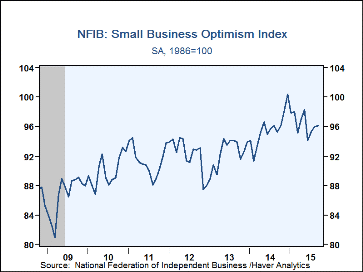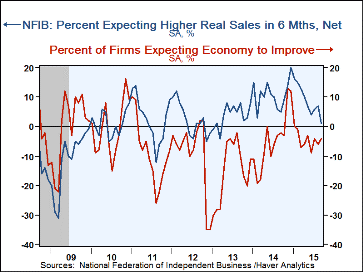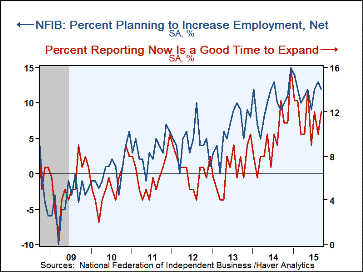 Global| Oct 13 2015
Global| Oct 13 2015NFIB Survey Contains Mixed Business Activity and Weak Price Readings
by:Tom Moeller
|in:Economy in Brief
Summary
The National Federation of Independent Business reported that its Small Business Optimism Index was little changed during September, nudging up to 96.1 from an unrevised 95.9 in August. The latest figure remained below the high of [...]
The National Federation of Independent Business reported that its Small Business Optimism Index was little changed during September, nudging up to 96.1 from an unrevised 95.9 in August. The latest figure remained below the high of 100.4 in December. According to the NFIB, the September level also remained below the 42-year average of 98 and was consistent with economic growth of 2.5%. Seven of the index's 10 components posted slight improvement.
As for business activity, 12% of firms reported that now was a good time to expand the business, up from 10% in August. The reading remained, however in the range of the last twelve months. The same can be said about the percentage of firms expecting the economy to improve. Weakening sharply to 1% was the percentage of firms expecting higher real sales in six months, down from 20% just nine months ago.
On the labor front, a smaller 12% of firms expected to increase employment, down from August and in the range of the last year. A lessened percentage found few or no qualified candidates to fill job openings. A fewer 27% of firms had positions they were not able to fill right now, also in this year's range. A stable net 23% of firms raised worker compensation over the last twelve months, but the percentage expecting to raise it in the next three months rose to 16%, a nine-month high.
Small businesses ability to improve conditions on the pricing front remained limited. Only one percent of firms were raising prices, down from 14% in July of last year. Expectations about the ability to raise prices collapsed. Just 13 percent of firms were planning to raise prices, down from a monthly high of 24% in 2011 and the lowest figure since late in 2010.
A slightly improved percentage expected credit conditions to ease, but the figure also remained well below the readings of the last year. Thirty percent of firms felt satisfied that their borrowing needs had been filled in the last three months, down sharply from six months ago. Only 2%, however, felt that their borrowing needs were not satisfied in the last three months, the least since 1999.
A fairly stable 22% reported government requirements as the largest single problem and the same percentage were troubled most by taxes. A sharply increased 16% were challenged by the quality of labor. A lessened 11% indicated poor sales; 7% reported competition from large businesses as well as insurance cost and availability. The cost of labor was indicated as a big problem by just 5% of firms and inflation was indicated by only 2%.
Roughly 24 million small businesses exist in the U.S. and they create 80% of all new jobs. The typical NFIB member employs 10 people and reports gross sales of about $500,000 a year. The NFIB figures can be found in Haver's SURVEYS database.
| National Federation of Independent Business | Sep | Aug | Jul | Sep'14 | 2014 | 2013 | 2012 |
|---|---|---|---|---|---|---|---|
| Small Business Optimism Index (SA, 1986=100) | 96.1 | 95.9 | 95.4 | 95.3 | 95.6 | 92.4 | 92.2 |
| Firms Reporting Now is a Good Time To Expand the Business | 12 | 10 | 12 | 13 | 10 | 7 | 7 |
| Firms Expecting Higher Real Sales In Six Months (SA, Net %) | 1 | 7 | 6 | 5 | 11 | 4 | 2 |
| Firms Expecting Economy To Improve (SA, Net %) | -4 | -6 | -4 | -2 | -5 | -15 | -9 |
| Firms Planning to Increase Employment (SA, Net %) | 12 | 13 | 12 | 9 | 10 | 6 | 4 |
| Firms With Few or No Qualified Applicants For Job Openings (SA, %) | 45 | 48 | 48 | 42 | 43 | 39 | 35 |
| Firms Reporting That Credit Was Harder To Get (SA, Net %) | 4 | 4 | 4 | 7 | 6 | 6 | 8 |
| Firms Raising Average Selling Prices (SA, Net %) | 1 | 1 | 5 | 4 | 8 | 2 | 4 |
Tom Moeller
AuthorMore in Author Profile »Prior to joining Haver Analytics in 2000, Mr. Moeller worked as the Economist at Chancellor Capital Management from 1985 to 1999. There, he developed comprehensive economic forecasts and interpreted economic data for equity and fixed income portfolio managers. Also at Chancellor, Mr. Moeller worked as an equity analyst and was responsible for researching and rating companies in the economically sensitive automobile and housing industries for investment in Chancellor’s equity portfolio. Prior to joining Chancellor, Mr. Moeller was an Economist at Citibank from 1979 to 1984. He also analyzed pricing behavior in the metals industry for the Council on Wage and Price Stability in Washington, D.C. In 1999, Mr. Moeller received the award for most accurate forecast from the Forecasters' Club of New York. From 1990 to 1992 he was President of the New York Association for Business Economists. Mr. Moeller earned an M.B.A. in Finance from Fordham University, where he graduated in 1987. He holds a Bachelor of Arts in Economics from George Washington University.










